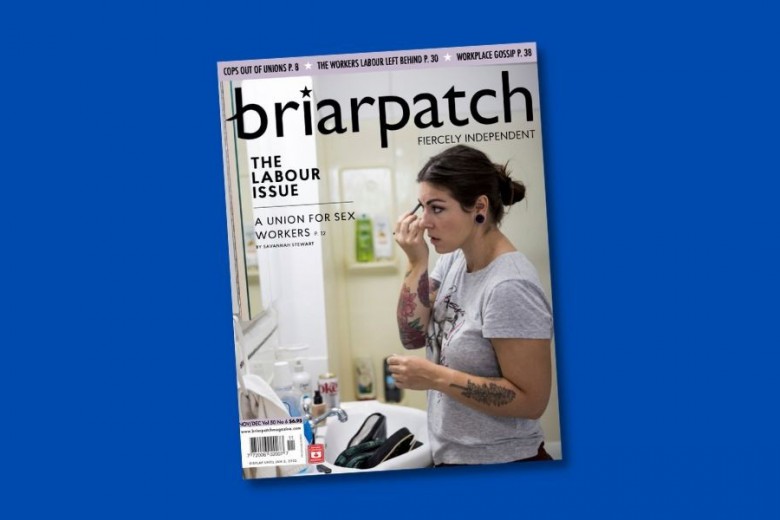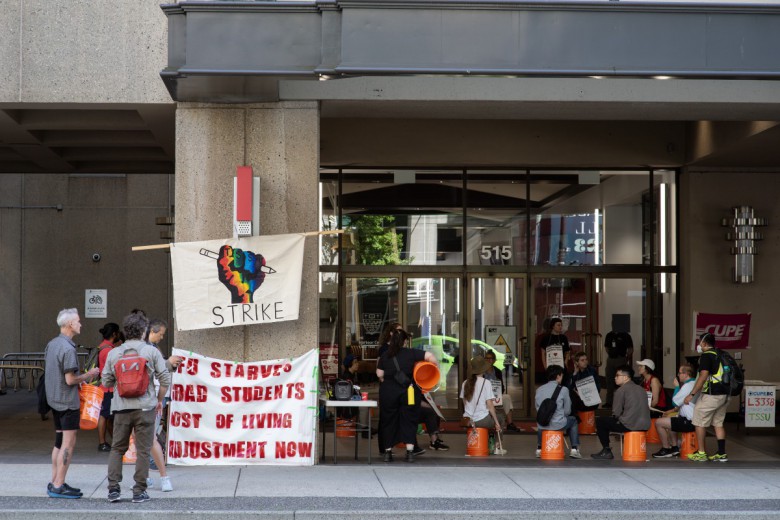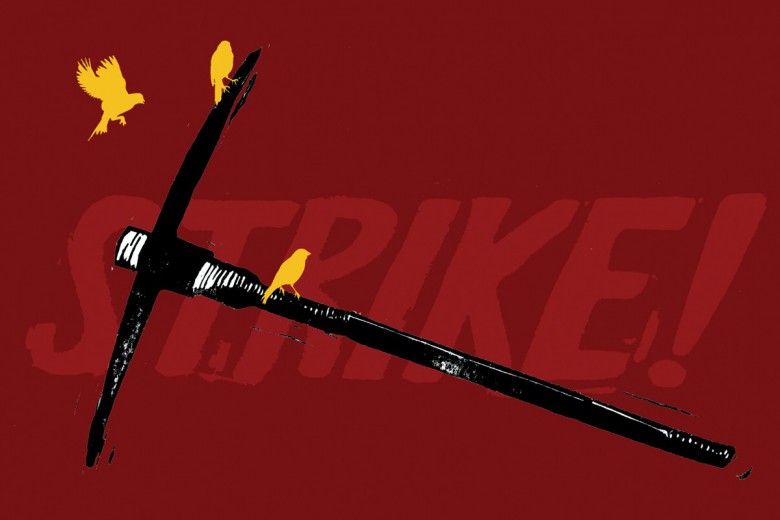In 2014, H.G. Watson, a freelance journalist and Ryerson journalism instructor, wrote for J-Source that “The labour beat – the reporters who write about workers, unions and all that it encompasses – has all but disappeared from newsrooms across North America. And with it, stories about workers’ struggles that are now slipping through the cracks.” By 2016, J-Source’s Errol Salamon had reversed course, pronouncing the beat “back from the dead.” So, which is it?
Watson, when asked if she still agrees with her characterization of labour journalism from 2014, now says that, in some ways, the field has rebounded.
“Yes and no. I think, if anything, we’ve seen a rise in the amount of reporting on labour even if we don’t necessarily call it labour – it’s not how, traditionally, labour has been viewed.”
In contrast to labour reporting in its heyday of the mid-1900s, which saw reporters covering union conferences and intra-union politics, labour reporting today is more likely to cover the struggles of non-unionized workers. “The way labour itself works has changed,” Watson explains. “We have much more precarious labour, we’ve seen the rise of contracts, of the changes in manufacturing, the shifts in what kind of labour people predominantly do – so I think that has, as well, shifted what labour reporting actually is.”
“I think, if anything, we’ve seen a rise in the amount of reporting on labour even if we don’t necessarily call it labour – it’s not how, traditionally, labour has been viewed.”
David Bush, an editor at RankandFile.ca, says the corporate consolidation of media ownership and the shuttering of local outlets has “pushed the labour beat aside to the point where we have a mainstream press situation in Ontario where there is one person who regularly covers workplace issues – that’s Sara Mojtehedzadeh from the Toronto Star.”
“She’s not even categorized as a labour reporter,” he adds. “She’s a ‘work and wealth’ reporter. She’s amazing; I would say one of the best reporters in the country on these issues. […] But that’s it; there’s no one else in that province and that’s a major, major problem.”
At the same time, Watson notes that the majority of labour reporting is being done by larger publications in big cities, like the Toronto Star, which leaves smaller centres without “local reporting and local accountability” on labour issues.
Salamon – a post-doctoral scholar at the University of Minnesota who studies political economy, media history, and digital media – says that labour journalism is a place with “pockets of hope.” But he also points out that, for a long time now, labour beats have been disintegrating, giving way to financial reporting.
All of Canada’s biggest English-language daily newspapers – the Globe and Mail, the National Post, the Toronto Star – have business sections or journals. But it wasn’t always that way; before the turn of the millennium, it was common for papers to have journalists assigned to the labour beat, and for statements by union leaders to be front-page news. In search of more moneyed readers, mainstream media stopped prioritizing workers’ issues and voices, focusing instead on financial markets. And today, when some of the biggest publications in Canada are owned by the richest men in the country, journalists enamoured with “objectivity” end up acting as a cudgel for the interests of their capitalist employers.
In search of more moneyed readers, mainstream media stopped prioritizing workers’ issues and voices, focusing instead on financial markets.
But as working conditions across the industry continue to deteriorate, there are some hopeful signs of an uptick in class consciousness among journalists. Salamon says, “One thing that we need to keep in mind as vital to labour journalistic coverage right now is that […] starting in June of 2015 we saw a wave of union organizing among digital journalists in the United States which has expanded into Canada.” In April 2016, for example, 170 workers at Vice Canada followed the lead of their American counterparts by unionizing with the Canadian Media Guild. And the wave hasn’t stopped: in March of this year, the six editorial news staff at BuzzFeed Canada joined the media union CWA Canada.
“As a result of that wave of union organizing, the journalists themselves that have been organizing have been (obviously) covering their own labour organizing in their own publications and in their competitors’ publications,” Salamon explains.
When workers at the newly unionized video, TV, and production arm of Vice U.S. got frustrated with the company dragging its feet on contract negotiations, they talked to reporters at HuffPost (where editorial staff are, like Vice’s video content creators and post-production workers, unionized with the Writers Guild of America, East). The ensuing story’s headline in HuffPost was, plainly, “Vice’s Unions Are Pissed Over Contract Talks.” This kind of labour reporting – which concerns itself with the well-being of workers rather than regurgitating the employer’s press releases – is only possible when journalists understand themselves as workers first and report in solidarity with their peers.
“Labour is central to all of the courses that I do teach”
Bush chalks the shift away from labour reporting up to “the changing nature of the capitalist press” – meaning an increase in corporate media ownership and consolidation. It’s a process that begins early, as labour education is left off of the curriculums of journalism schools across the country. But university campuses are also potentially fertile ground on which to resurrect Canada’s languishing labour journalism.
Renée Lalonde, who studied journalism and public relations from 2012 to 2015 at Sheridan College, says that when she was a student “No one discussed labour rights, unions, or anything to that effect.”
Watson, in her roles as a lecturer at Humber College and Ryerson University, says that schools instead focus on the foundational aspects of journalistic practice.
“Aside from knowing the particulars of how labour movements work, reporting on labour is no different than reporting any other beat – you’re just looking for your sources, you’re getting all your facts right,” she explains. “So I think that’s the main thing, really, is just focusing on what the fundamentals are.”
But that assumption – that journalists will know how the labour movement works without being taught it in school – can have huge consequences. Journalists who don’t know the first thing about organized labour might oversimplify complicated negotiations, uncritically adopt employer-side language like “replacement worker” instead of “scab” in an effort to “remain objective,” or describe anyone holding a picket sign as being “on strike.” The last 30 years of neoliberal attacks have caused a decline in unionization rates in Canada and the U.S., accompanied by a weakening in public understanding of the value of unions. Journalists are no exception to this norm.
This kind of labour reporting – which concerns itself with the well-being of workers rather than regurgitating the employer’s press releases – is only possible when journalists understand themselves as workers first and report in solidarity with their peers.
Salamon, a 2005 graduate of Ryerson’s bachelor of journalism program, says there were no courses dedicated to labour journalism in his program and that the same exploitative labour practices journalists face today – like unpaid internships and overtime – were present then.
“I don’t teach any courses that are called ‘labour journalism,’ but labour is central to all of the courses that I do teach,” he says. “So, one way that I, and other faculty, can build a program and contribute to pedagogy of labour journalism is incorporating labour journalism into all of the courses that we teach, whether or not they are specifically focused on labour journalism.”
In the absence of classes on how to cover labour disputes, student journalists are instead honing their labour-reporting skills by covering campus labour issues – and learning to understand themselves as workers along the way.
In March, Concordia undergraduate journalism students joined other Quebec students in a general strike in protest of unpaid internships. They were demanding wages for all interns and the associated benefits and protections under Quebec’s labour code. Three Concordia journalism students – Miriam Lafontaine, Erika Morris, and Jon Milton, all of whom are currently or previously involved with the Link, one of Concordia’s campus media outlets – proposed a department-wide strike and mobilized to make it happen.
“Me and a few people in the journalism department were thinking, well, unpaid internships are a huge problem in journalism, so maybe this is an opportunity for the journalism department to join this wider movement happening right now,” explains Lafontaine, then on the editorial staff at the Link. “And so then, in December, we started preparing what we were going to do to vote [to] strike.”
During the week-long strike, Lafontaine and her colleagues held a press conference and gave interviews to various media outlets, including the CBC. They wanted to emphasize the mainstream media’s responsibility in paying journalism students for internships. CBC Radio, for example, does not pay their interns, who work full time for six weeks at CBC/Radio-Canada.
“It’s a bit uncomfortable if you’re a station that has unpaid interns and then you invite someone to talk about this.”
Instead of interviewing striking students, some outlets chose to simply pull quotes from organizers’ press releases and public statements. Lafontaine believes that it was because many of those outlets continue to use unpaid student labour. For example, CTV – owned by Bell Media, the same company that owns CJAD 800, where Lafontaine interned without pay – didn’t interview organizers. “It’s a bit uncomfortable if you’re a station that has unpaid interns and then you invite someone to talk about this,” she notes. Despite the disappointing coverage from some outlets, she says “there [were] a lot of journalists in the city who put the right effort in to cover it the right way.”
Though the fight is far from over – Quebec students continue to be denied many labour rights by the provincial government – the strikes by Concordia’s journalism students led to paid internship opportunities at the school, a fundamental demand of those students who participated in the strike.
The Link’s coverage of the strike appeared in a special issue on labour – the first of its kind on Concordia’s campus.
“Working-class people can feel antagonized by the media sometimes […] because the media [doesn’t] really centre their stories anymore,” explains Thomas Delbano, a Concordia journalism student who contributed an article to that issue, titled “After a Decline, Interest in Labour Reporting Appears to Be Growing.” He believes that labour journalism can disrupt the view workers have of the media and “is a way to connect with a larger part of the audience.”
“When student papers and student journalists stumble upon, or do good reporting for labour, those stories can often be picked up by larger outlets [which] give these issues a larger hearing.”
Jon Milton – who was involved in organizing the Concordia journalism students’ strike – says that there is no dedicated labour journalism training at Concordia and that much of his knowledge about unions comes from being a member of a freelancers’ union, the Syndicat associatif des travailleuses et travailleurs autonomes du Québec (S’ATTAQ, a branch of the Industrial Workers of the World).
“In a lot of cases – at least, in Montreal, you see this – student journalists, when doing their work properly, can set the tone for a lot of larger media outlets because so many high-profile journalists are former student journalists [who] continue to read the student papers that they used to work at,” he notes. “And so that means when student papers and student journalists stumble upon, or do good reporting for labour, those stories can often be picked up by larger outlets [which] give these issues a larger hearing.” Such was the case with the Link’s coverage of the Concordia journalism students’ strike, which was published online two months before CBC picked up the story.
At the University of Regina – where I am the editor-in-chief of the campus newspaper, the Carillon – we recently saw the faculty association adopt a strike mandate after the university balked at their extremely reasonable demands. In response, the university hired a crisis PR firm to handle communication. The Carillon was instrumental in covering the negotiations; our articles on the subject remain some of the most-read on our website. Our readers’ obvious interest in journalism related to campus labour disputes dispels the notion that labour journalism is of little interest to readers outside of niche publications.
“I’ve seen reporting from [student papers] across the States, from across Canada, looking at unionization struggles of cleaning staff and faculty, and a lot of times that’s some of the best reporting that paper puts out,” Watson adds, pointing to past John H. McDonald (JHM) award winners as examples. The JHM awards are presented annually by the Canadian University Press to recognize the best student journalism in a number of categories, including labour. Nominees in 2019’s labour category included a piece in George Brown College’s the Dialog about international students working precarious and undocumented jobs, an article in the University of British Columbia’s Ubyssey on the low wages and lack of security facing the university’s sessionals, and a feature in the Ubyssey on the outcry over a sweetheart union deal between UBC Okanagan and the UBC Faculty Association.
“That’s very front-line journalism especially because a lot of […] newsrooms have been so financially decimated, they may not be paying as close attention to [these struggles], so it’s so important that student journalists are there,” says Watson.
“And then, as well, if you look at who is going to be most affected by these changes we’ve seen in our labour workplace, it’s millennials and Gen Z,” she continues. “And that is who is sitting on college campuses.”
“I think student media is really well positioned to be at the front lines of reporting on that.”







